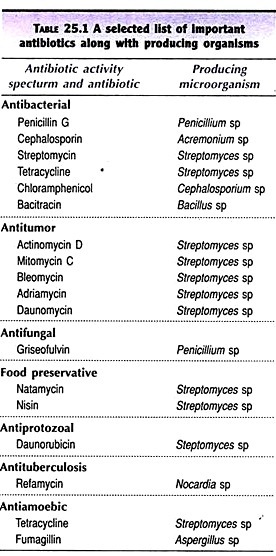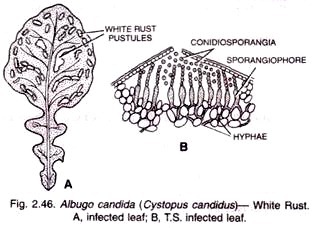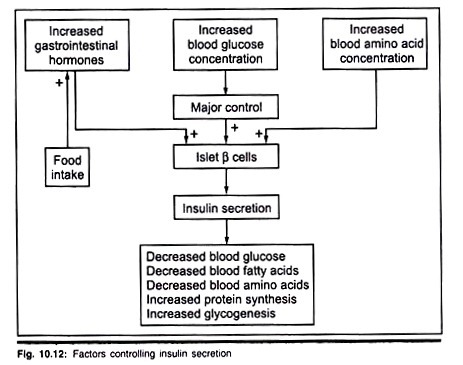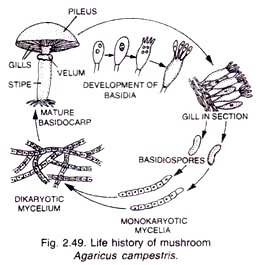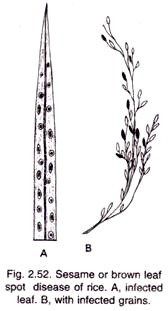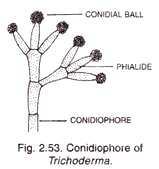In this article we will discuss about the classification of Fungi.
Oomycetes – The Oogamous Fungi:
Some of the important points of Oomycetes are listed below:
1. The mycelium is coenocyte (multinucleate and aseptate).
2. Hyphal wall contains cellulose and other glucans in many members. In some cases chitin or fungus cellulose is also present.
3. Asexual reproduction involves the formation of spore containing sacs or sporangia. In aquatic conditions the sporangia produce zoospores. In terrestrial conditions the sporangia often behave as spores, equivalent to conidia. Because of it, the sporangia are often called conidiosporangia.
4. Zoospores are generally biflagellate with heterokont flagellation in which one flagellum is smooth while the other is of tinsel type (having fine surface outgrowths Called mastigonemes).
5. Gametes are usually non-flagellate.
6. Sexual reproduction is by gametangial contact in which the male sex organs or antheridium passes its product into the female sex organ or oogonium through a fertilization tube.
7. The product of sexual reproduction is oospore.
Examples:
1. Late Blight:
Phytophthora infestans causes late blight of Potato and occasionally of Tomato as well. Blight is the appearance of brownish to black dead areas.
They are first formed on the margins and tips of leaflets. Later on the whole foliage becomes blighted. Tuber yield is reduced. The surface of the tubers also shows blighting. Irish famine of 1845- 1847 was caused by late blight of Potato.
2. White Rust:
It occurs in crucifers and is characterised by the appearance irregular white blisters containing, conidiosporangia on the leaves and stems. White rust is caused by Albugo Candida (= Cystopus Candidas: Fig. (2.46).
3. Damping off:
Pythium debaryanum kills seedlings of a number of plants through collapse of stem just above the ground level.
4. Downy Mildew:
The pathogen produces a cottony or wooly bloom on the surface of the host. Sclerospora graminicola spreads downy mildew in cereals and green ear disease of Pennisetum typhoides (vem. Bajra). Peronospora parasitica causes downy mildew in a number of plants, e.g., Pea, Mustard, Spinach, Onion, etc..
Zygomycetes – The Conjugation Fungi:
1. It is a class of terrestrial fungi which are mostly saprotrophic, rarely parasitic.
2. The mycelium is coenocytic (multinucleate, aseptate).
3. Hyphal wall contains chitin or fungus cellulose.
4. Motile cells (zoospores and planogametes) are absent.
5. Mito-spores are non-motile. They are called sporangiospores as the spores are formed inside sporangia borne at the tips of special hyphae called sporangiophores.
6. Sexual reproduction occurs through gametangial copulation or conjugation. Because of it, zygomycetes are also called conjugation fungi.
7. The gametes are multinucleate and are called coenogametes.
8. Sexual reproduction produces a resting diploid spore called zygospore. Because of the presence of zygospore, the group of fungi is called zygomycetes. Zygospore differs from oospore in that during its formation a distinct large food laden non-motile female gamete is not produced.
9. Zygospore does not give rise to new mycelium directly. Instead it produces a new sporangium called germ sporangium (previously called zygospo-rangium). Germ sporangium forms meiospores called germ spores.
Examples:
1. Squirting Fungus:
Pilobolus crystallinus is a coprophilous or dung mould in which mature sporangia are thrown away up to a distance of 2m.
2. Rhizopus and Mucor:
Rhizopus stolonifer (= R. nigricans) is popularly known as black bread mould. Mucor caninus or M. mucedo is coprophilous. It is also called dung mould. Rhizopus and Mucor are the common saprotrophic fungi that attack a variety of food stuffs.
Soft rot or leak disease of Strawberry, Apple, Sweet Potato, etc. is due to Rhizopus. Mucor pusillus causes infection of internal organs in human beings. Absidia corymbifera causes bronchomycosis. Both Rhizopus and Mucor species (e.g., Rhizopus oryzae, Mucor javanicus) are used in alcoholic fermentation. The two also produce a number of organic acids like citric acid, lactic acid and fumaric acid.
Ascomycetes – The Sac Fungi:
Some of the important points of Ascomycetes are listed below:
1. Ascomycetes (Gk. askos- sac, mykes- fungus) is a class of diverse fungi numbering over 30,000 species. They include pigmented moulds (brown, green, blue, pink), powdery mildews, yeasts, cup fungi, morels and truffles. Nutritionally they are saprotrophic, decomposers, coprophilous or parasitic.
2. The mycelium consists of septate hyphae. Yeasts are an exception in that they are basically unicellular. They may, however, form short temporary filamentous structure called pseudo-mycelium.
3. The septa possess central pores called septal pores. The pores allow communication between adjacent cells. Septal pores show plugging of different types.
4. Cell wall contains chitin or fungus cellulose.
5. Motile structures do not occur in the life cycle.
6. In yeasts, asexual reproduction occurs through budding and fission. Oidia stage, similar to yeast, is found. In some other ascomycetes as well.
7. In majority of ascomycetes, the common mode of asexual reproduction is through the formation of conidia (singular-conidium). Conidia are non-motile fungal mitospores which are produced exogenously from the tips and sides of hyphae called conidiophores.
Conidia are often coloured brown, green, blue or pink. They provide colouration to the fungus. Greenish and bluish growth on bread, citrus fruits and old leather is due to moulds belonging to ascomycetes e.g., Penicillium, Aspergillus.
8. Conidiophores may be branched or un-branched, scattered or aggregated to form structures like acervulus, synnema, sporodochium, etc.
9. Sexual reproduction takes place through fusion of sex cells, somatic cells, gametangial contact between an antheridium and ascogonium, and autogamy.
10. Fertilization occurs in two steps, plasmogamy and karyogamy. Karyogamy is delayed after plasmogamy. A new transitional phase appears in the life cycle. It is called dikaryophase. The cells of dikaryophase are called dikaryotic cells. Each such cell possesses two nuclei (n+n).
11. Some dikaryotic cells function as ascus mother cells. The latter act as the seats of both karyogamy and meiosis. This converts the cells into asci (singular- ascus).
12. Ascus is a sporangial sac peculiar to ascomycetes. 4-8 haploid meiospores named ascospores are produced internally in each ascus. In most of the cases half the number of ascospores belong to one mating type while the other half belong to the second mating type.
13. The asci may occur freely or get aggregated with dikaryotic mycelium to form fructifications called ascocarps. Ascocarps are of many types: cup-like (apothecium, e.g., Peziza), flask-shaped (perithecium e.g., Neurospora), elongated with a slit (hysterothecium) or closed (cleistothecium e.g., Penicillium). The fructifications of some ascomycetes are edible and considered delicacies, e.g., morels, truffles.
Examples:
1. Yeasts:
Yeasts are a group of non-mycelial or pseudomycelial ascomycetes which multiply asexually by budding or fission and where asci are not organised into ascocarps.
Depending upon the mode of asexual reproduction, yeasts are of three types— budding yeasts e.g. Saccharomyces), fission yeasts (e.g., Schizosaccharomyces) and halobial yeasts (both budding and fission, e.g., Saccharomycoides). Yeasts in which ascus formation is known are named as true yeasts.
Related forms which resemble yeasts in most characteristics but where ascus formation is not reported are called false yeasts, e.g., Candida, Mycoderma, and Cryptococcus. They are otherwise included amongst deuteromycetes.
Economic Importance:
(i) Brewing Industry:
Under anaerobic conditions sugary solutions inoculated with yeasts are converted into alcoholic beverages, e.g., beer, wine, cider, toddy. They are concentrated further to produce rum and whisky. The two common yeasts used by brewing industry are Saccharomyces cerevisiae (Beer or Baker’s yeast) and S. ellipsoidens (Wine Yeast),
(ii) Baking Industry:
Kneaded flour is inoculated with Saccharomyces cerevisiae (Baker’s Yeast). It produces carbon dioxide and alcohol. The two evaporate during baking, making the dough soft and spongy,
(iii) Vitaminised Food:
Yeast used in brewing industry is regularly harvested and used as vitaminised food,
(iv) Curing:
Yeasts are used in curing cocoa beans,
(v) Spoilage of Food:
Being saprotrophic, yeasts attack various food stuffs including tomato products, foods having lactic acid and carbonated beverages,
(vi) Silk Industry:
Some yeast reduces the yield of silk industry by attacking silkworms,
(vii) Plant Diseases:
Species of Nematospora attack Cotton, Tomato and Beans,
(viii) Human Diseases:
Candida albicans causes thrush and inflammation of genitalia. Cryptococcus neoformans attacks nervous system producing lesions, meningitis and brain tumour. Torula produces skin nodules and lesions of viscera.
2. Aspergillus:
It is a common green smoky mould which not only contaminates laboratory cultures (hence weed of laboratory) but also various food stuffs including bread, butter, cheese, syrups, jams, jellies, textile and leather goods. It causes rotting of dates, figs, pomegranates, cigars and tobacco.
Some lung (pulmonary aspergillosis) and ear infections are caused by Aspergillus species. Fermentation effected by Aspergillus yields alcohol (Sake of Japan), citric acid, gluconic acid, glycerol, В-complex vitamins, enzymes and antibiotics.
3. Penicillium:
P. chrysogenum yields the antibiotic penicillin. The latter was the first commercial antibiotic. It was formerly obtained from P. notatum. P. griseofulvum produces antifungal drug griseofulvin.
The fungus is employed in ripening of cheese (camembert and roquefort varieties) and production of organic acids. The fungus is otherwise known to spoil food, citrus fruits, apple, grape, paper, wood and ensilage. The blue-green mould appearing on citrus fruits is Penicillium.
4. Neurospora (Pink Bread Mould):
N. crassa is often employed in studies conducted in experimental genetics. It is often called “Drosophila of plant kingdom”.
5. Erysiphe:
The fungus produces powdery mildew (fungal disease in which pathogen results in a powdery coating on the surface of the host), e.g., Erysiphe graminicola (E. graminis, on cereals like Wheat, Barley), E. polygoni (on legumes like Pea).
6. Claviceps:
Claviceps purpurea produces ergot of rye and other cereals in which ears come to have sclerotia of the fungus. Eating of infected cereals produces ergotism. Ergotism is of two types, gangrenous and spasmodic. The sclerotia contain a number of alkaloids, the most important being lysergic acid.
Ergot is used as a medicine to control migraine, enlarged prostate glands and uterine haemorrhage after child birth. These days lysergic acid is prepared through fermentation activity of C. paspali. LSD, a hallucinogen, is D-lysergic acid diethylamide-15.
7. Sclerotinia:
S. fruticola causes brown rot of Peach, Plum and Pear.
8. Cup Fungi:
The ascocarp is cup-shaped, e.g., Peziza.
9. Morels:
Morels are ascomycetes with edible ascocarps that have fleshy sponge-like conical cap or pileus and a stalk like stipe, e.g., Morchella esculenta (vern. Gucchi), M. crassipes, M. deliciosia.
10. Truffles:
They are edible ascomycetes with tuber-like subterranean ascocarps that are often dug out with the help of trained dogs and pigs, e.g., Tuber uncinatum, T. aestivum.
Basidiomycetes – The Club Fungi:
1. Basidiomycetes (Gk. basidium- small base, mykes- fungus) are the most advanced and most commonly seen fungi as their fructifications are often large and conspicuous, e.g., mushrooms (gill fungi), toadstools, puff balls, bracket fungi, etc.
2. The class contains about 25,000 species.
3. Basidiomycetes are among the best decomposers of wood. Only a few insects can compete with basidiomycetes in decomposing hard woods and woody structures of trees. Basidiomycetes are able to decompose both cellulose and lignin. Lignin is not metabolised by most other fungi and even bacteria.
For decomposing wood, these fungi secrete cellulose and lignin digesting enzymes. The enzymes create spaces in the wood for hyphae to pass inwardly. It is because of this that we sometimes observe toadstools and mushrooms to come out of wooden structures. Ganoderma species causes decay of wood even of standing trees.
4. Motile structures or cells are absent.
5. Mycelia are of two types, primary and secondary. Primary mycelium contains monokaryotic cells, that is, cells with single haploid nuclei (n).
6. Monokaryotic phase or primary mycelium may multiply by oidia, conidia-like spores and pycniospores. Dikaryotic mycelium does not multiply by asexual spores.
7. There is often differentiation of two mating types, (+) and (-).
8. Sexual reproduction does not involve sex organs. Instead plasmogamy (fusion of protoplasts without fusion of their nuclei) occurs by fusion between basidiospores and other monokaryotic spores, between a spore or spermatium and a hypha or between two hyphal cells of primary mycelia.
9. Karyogamy is delayed for long. The intervening phase is called dikaryophase. It produces a new mycelium called secondary mycelium which is dikaryotic (n+n).
10. Secondary mycelium is long lived. It consists of profusely branched septate hyphae.
11. Septa possess dolipores or central pores with barrel-shaped outgrowths.
12. Hook-shaped outgrowths are found on the sides of septa. They are called clamp connections. Clamp connections are meant for proper distribution of dikaryons at the time of cell division.
13. Secondary mycelium can perennate in the soil or wood by means of sclerotia (often rounded or ellipsoid firm masses of hyphae) or rhizomorphs (root-like aggregation of hyphae with well defined apical meristems).
14. Dikaryophase or secondary mycelium may multiply by different types of spores— chlamydospores, aecidiospores, uredospores, teleutospores, etc.
15. Karyogamy and meiosis occur in club-shaped structures known as basidia (singular— basidium). The name of the class is based after them. A basidium may be aseptate (holobasidium) or septate vertically or transversely (phragmobasidium).
16. A basidium commonly produces four meiospores or basidiospores exogenously at the tips of fine outgrowths called sterigmata.
17. The fungi may or may not produce fructifications called basidiocarps. The basidiocarps vary from microscopic forms to large macroscopic structures. Some puff balls and brackets can be over 50 cm in diameter.
Examples:
1. Rusts:
They are characterised by the formation of rusty pustules containing the spores. A basidiocarp is absent, (i) Puccinia graminis tritici — black rust of wheat, (ii) Puccinia glumarum — yellow rust of wheat, (iii) Hemileia vastatrix — leaf rust of coffee.
2. Smuts:
They produce thick-walled black-coloured resting spores called smut spores (= teleutospores = chlamydospores). Smuts are of two types, covered and loose. In covered smuts the spore mass remains within the host till the latter is set free, e.g. Ustilago maydis (smut of corn), Tilletia tritici (bunt or stinking smut of wheat). In loose smut the spores are exposed while attached to the host, e.g. Ustilago tritici (loose smut of wheat).
3. Mushrooms:
They are edible and nonedible agaric ales which possess umbrella like basidiocarp the edible mushrooms generally possess coloured basidiospores. Common examples are Agaricus campestris, Agaricus brunnescens (= A. bisporus), Volvariella volvacea (Paddy Straw Mushroom), Lentinus edodes (Shiitake Mushroom).
4. Toadstools:
Toadstools are nonedible, often poisonous mushrooms which generally have white spores. Amanita caesarea (Caesaer’s Mushroom) was used in poisoning Roman emperor Caesar. The other toadstools are Amanita phalloides (Death Cap) and A. muscaria (Fly Agaric).
5. Bracket Fungi (Shelf Fungi):
The basidiocarps or fructifications appear on tree trunks, logs, lumber, etc. just as brackets or shelves, e.g. Fomes applanatus (perennial), Polyporus sulphureus (annual).
6. Puffballs:
The basidiocarp is a stalked rounded structure which on ripening sends out puffs of spores. The fructification may grow above or below the substratum. Puffballs are odoriferous. They are edible in the young state, e.g. Lycoperdon oblongisporum, L. giganteum.
7. Armillariella (= Armillana):
A. mellea (Honey Mushroom) is an edible mushroom which is a serious root parasite of both hardwoods and conifers. The fungus sends rhizomorphs into the phloem of the host and hence block the food supply.
8. Hallucinogens:
Psilocybe mexicana (Sacred Mushroom) has hallucinating properties similar to LSD. It is used by Mexican Indians for certain religious ceremonies.
Deuteromycetes – The Fungi Imperfecti:
Some of the important points of Deuteromycetes are listed below:
1. Deuteromycetes is an artificial class of fungi which has been created to include all those fungi in which sexual stage is either absent or not known.
2. Some of the deuteromycetes are unicellular like yeasts. They are often studied along with the latter.
3. The mycelium is usually septate. Coenocytic forms are not known. Clamp connections, typical of basidiomycetes, are absent.
4. Asexual reproduction often occurs by conidia along with some other types of spores. In some cases even asexual spores are absent.
5. It is believed that most members of deuteromycetes are actually ascomycetes in which sexual reproduction is either absent or yet to be discovered.
Examples:
1. Red Rot (Fig. 2.51):
Colletotrichum falcatum produces red rot of sugarcane which is conspicuous on leaf midribs as well as in canes. It reduces juice content of canes and brings about withering of leaves. The fungus develops sickle-shaped conidia. The perfect stage is Glomerella tucumanensis.
2. Helminthosporium (Fig. 2.52):
Helminthosporium oryzae causes leaf spot disease of rice commonly called sesame or brown leaf spot of rice. It caused Bengal famine of 1942-43 and similar conditions in Krishna-Godavari area in 1989-1990. The perfect stage of the fungus is Cochliobolus miyabeanus. The conidia are 5-10 septate.
3. Early Blight:
Alternaria sotani causes early blight of Potato and Tomato. The leaves develop small oval brown spots with concentric rings. The leaves as well as the branches wither and fall down. The conidia are beaked bottle-like multi-septate with a number of transverse and a few longitudinal septa.
4. Tikka Disease:
Circular necrotic dark brown or blackish leaf spots develop in groundnut due to Cercospora (e.g. C. personata). The conidia are septate and filamentous. The perfect stage is Mycosphaerella (e.g., M. berkeleyii).
5. Wilts:
Many economically important plants (e.g., Potato, Tomato, Cotton, Banana, Flax, Pigeon Pea) show sudden signs of wilting due to blockage of tracheary elements by growth of fungus Fusarium especially F. oxysporum. The fungus shows three types of spores — chlamydospores, micro conidia and macro conidia.
6. Gibberellins:
They were first discovered in the extracts of Fusarium moniliformae growing on rice (bakane or foolish disease of rice). The perfect stage of fungus is Gibberella fujikuroi. Gibberellins are natural plant growth hormones.
7. Trichoderma (Fig. 2.53).
It is a soil fungus used in biological control of other fungi as it produces allelochemics against them. If the fungus happens to pass into human alimentary canal it produces leucopenia called alimentary canal aleukia.

